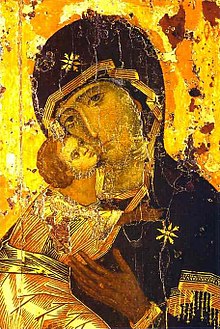| Revision as of 22:30, 31 July 2005 editMatrona (talk | contribs)133 editsm Our Lady of Vladimir moved to Theotokos of Vladimir← Previous edit | Revision as of 22:35, 31 July 2005 edit undoMatrona (talk | contribs)133 edits correcting errors based on former title of articleNext edit → | ||
| Line 1: | Line 1: | ||
| ] | ] | ||
| ''' |
The '''Theotokos of Vladimir''', also known as the Virgin of Vladimir or ''Vladimirskaya'', (]: Владимирская Богоматерь -- ''the Mother of God, of Vladimir'') is one of the most venerated ] icons. The Theotokos is regarded as the ] protectress of ], and the ] is displayed in the ], Moscow. | ||
| ] ] of ] sent the newly-written icon as a gift to ] ] of ] about ]. The beautiful image was coveted by Yury's son ] who brought it to his favourite city ] in ]. When the horses that transported the icon stopped near Vladimir and refused to go further, this was interpreted as a ] that the ] wanted her icon to stay in Vladimir. To house the icon, the great Assumption cathedral was built there, followed by other churches dedicated to the Virgin throughout northwestern Russia. | ] ] of ] sent the newly-written icon as a gift to ] ] of ] about ]. The beautiful image was coveted by Yury's son ] who brought it to his favourite city ] in ]. When the horses that transported the icon stopped near Vladimir and refused to go further, this was interpreted as a ] that the ] wanted her icon to stay in Vladimir. To house the icon, the great Assumption cathedral was built there, followed by other churches dedicated to the Virgin throughout northwestern Russia. | ||
Revision as of 22:35, 31 July 2005

The Theotokos of Vladimir, also known as the Virgin of Vladimir or Vladimirskaya, (Russian: Владимирская Богоматерь -- the Mother of God, of Vladimir) is one of the most venerated Orthodox icons. The Theotokos is regarded as the holy protectress of Russia, and the icon is displayed in the Tretyakov Gallery, Moscow.
Patriarch Luke Chrysoberges of Constantinople sent the newly-written icon as a gift to Grand Duke Yury Dolgoruky of Kiev about 1131. The beautiful image was coveted by Yury's son Andrei the Pious who brought it to his favourite city Vladimir in 1155. When the horses that transported the icon stopped near Vladimir and refused to go further, this was interpreted as a sign that the Theotokos wanted her icon to stay in Vladimir. To house the icon, the great Assumption cathedral was built there, followed by other churches dedicated to the Virgin throughout northwestern Russia.
In 1395, during Tamerlane's invasion, the image was taken from Vladimir to the new capital, Moscow. The spot where people and the ruling prince met the icon is commemorated with the Sretensky monastery. Vasili I of Moscow spent a night crying over the icon, and Tamerlane's armies retreated the same day. The Muscovites refused to return the icon to Vladimir and placed it in the Cathedral of the Dormition of the Moscow Kremlin. The intercession of the Theotokos through the image was also credited with saving Moscow from Tatar hordes in 1451 and 1480.
One of the most exquisite icons ever written, the image of the Theotokos of Vladimir is imbued with universal feelings of motherly love and anxiety for her child. By the 16th century the Vladimirskaya (as the Russians call it) was a thing of legend. It was even rumoured that the icon was written by St Luke on the Lord's table of the Last Supper. The venerated image was used in coronations of tsars, elections of patriarchs, and other important ceremonies of state. In December 1941, as the Germans approached Moscow, Stalin ordered that the icon be placed in an airplane and flown around the besieged capital. Several days later, the German army started to retreat.